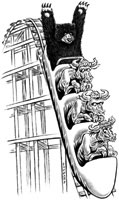 Yesterday was a wild one and today is our last day before we get some real data to play with.
Yesterday was a wild one and today is our last day before we get some real data to play with.
While I REALLY want to be able to put on a happy face, I have tossed and turned on this all night and I have decided that I am still fairly bearish, despite the big sell-off (which looks a little overdone) and despite this morning's pre-market excitement.
Had we had this bounce at 2:01 yesterday, I would have felt better about it, I would have thought that real buyers were anxious to get back in the market and put money back to work but we DROPPED 125 points AFTER the Fed minutes were released and trading curbs had to be placed on the markets near the days end.
If we are rallying, we are rallying on the basis that the economy is falling apart so rapidly that the Fed will have to reverse their posture and cut rates. Whoopee! Where do I sign up? Also, do you really imagine that a rate cut from the Fed, EVEN a 1% rate cut, will save a person with a $250,000 mortgage whose 1.5% ($862/month) "teaser rate" is about to jump up to 7% ($1,663/month). Is a 6% rate ($1,498/month) going to keep them in the house?
Now what about the people who have $400,000 loans? What about the small business owners who took adjustable lines of credit to get their business going during the past few years or the thousands of existing businesses who tapped the flow of easy capital with loans that ratchet up. Is 1% going to save them? Is 1% even on the table?
I still maintain that it would be a HUGE mistake for the Fed to demonstrate its impotence by firing their big gun into an overbought market to bail out speculators who bought at the top. Defending $72 oil (up 80% in 3 years), $675 gold (up 68%), runaway food prices (up 32%), $248,000 median home prices (up 25%) or equities that are up 35% is NOT in line with the Fed's stated goal of fighting inflation.
The original mandate for the Federal Reserve in 1913 was to "prevent financial panics and bank runs by providing loans to the banking system." This led to the Fed supporting a runaway bubble economy in the 20s that ended quite badly for everyone (well, almost everyone). In the aftermath of the Great Depression, the 1946 Employment Act required the Fed to pursue "conditions under which there will be afforded useful employment opportunities … for those able, willing, and seeking to work, and to promote maximum employment, production, and purchasing power." In 1978, the Full Employment and Balanced Growth Act required the federal government to "promote full employment … and reasonable price stability."
The Fed has slowly but surely drifted away from their Carter-era mandate and moved back to the Federal reserve of Herbert Hoover, defending corporate interests ahead of those of the citizens.
As Michael Shedlock pointed out (when the Fed conceded to Cramer's plea to bail out his hedge fund buddies by opening the discount window on the 17th): "Once again the Fed refuses to let the free market work. Bernanke is no better than Greenspan; he proved it today. The moral hazard of the Fed's actions are if anything likely to accelerate, but they won't work. Here is the key: There is both a decreasing demand for credit and a decreasing willingness to extend it. But there is a hell of a lot of pent up demand for cash. To understand the difference, please see Sudden Demand For Cash."
"The psychology towards risk has changed and that is why Bernanke is doomed to fail. He can either let the free markets work, or he can risk letting this play out over 18 years like Japan did. Given his misguided beliefs about the cause of the great depression, his path is already laid out."
Now, let's get positive!
Asia had a slight (for them) sell-off with the Nikkei dropping 274 points and the Hang Seng off 343 points but both indexes made a bit of a recovery towards the end of the day. When there is no after-market news in the US there is little for Asia to do but follow our markets as they wake up (in the Land of the Rising Sun) while the rest of the civilized world is fast asleep so nothing we know at 3:30 is any different than what they know at 9:30. It's the later-day action in Asia that usually gets my attention…
There was no particular bad news other than China's CB acknowledging that consumer price inflation could exceed the government's target of 3% this year, but they said the problem remains confined to food and expressed confidence that the government can keep overall prices under control. "Even though we have increased our macroeconomic control efforts, price increases this year might still exceed 3%. We believe that as food prices are controlled, inflation will also be effectively curbed." See yeserday's article on denial but we'll give them a pass for today.
 Europe is making huge gains off a terrible open but is faltering near yesterday's tepid close. In a story you would think would not be buried today by an objective MSM: "A London money management firm, Cheyne Capital Management, may be forced to liquidate the assets backing its $10 billion commercial paper program in the latest casualty of the jittery credit market. Standard & Poor's abruptly downgraded, by six notches, the ratings of the short-term notes issued by Cheyne Finance, a structured investment vehicle that the fund uses to bolster returns." We can add this letter to our collection of hedge fund blow-ups.
Europe is making huge gains off a terrible open but is faltering near yesterday's tepid close. In a story you would think would not be buried today by an objective MSM: "A London money management firm, Cheyne Capital Management, may be forced to liquidate the assets backing its $10 billion commercial paper program in the latest casualty of the jittery credit market. Standard & Poor's abruptly downgraded, by six notches, the ratings of the short-term notes issued by Cheyne Finance, a structured investment vehicle that the fund uses to bolster returns." We can add this letter to our collection of hedge fund blow-ups.
In news you are likely to hear a LOT more about (and thanks to Bigsmokey for posting this!): "Politicians, regulators and financial specialists outside the United States are seeking a role in oversight of American markets, banks and rating agencies in the wake of recent problems related to subprime mortgages." Oh sure, like WE'RE the bad guys, like WE'RE the irresponsible ones, like WE make insane loans on overpriced assets… Oh yeah, that IS us!
Their argument is simple: The United States is exporting financial products, but losses to investors in other countries suggest that American regulators are not properly monitoring the products or alerting investors to the risks. "We need an international approach, and the United States needs to be part of it," said Peter Bofinger, a member of the German government's economics advisory board. "America depends on the rest of the world to finance its debt," Bofinger said. "If our institutions stopped buying their financial products, it would hurt."
Back home, we stick to my plan from last night, which is: Don't panic (yet) and remember that we take our index puts to protect our calls so if we end up neutral it is, literally, no loss. We will let the market be our guide, keeping an eye on our levels. If we retake them, we can consider getting bullish – scaling back on our puts and adding calls but if we, like Europe is doing, sputter around there, it may be a good opportunity to lighten up on the calls and tighten up our downside protection.
We have our oil inventory report at 10:30 and we should get some kind of rebound in the energy patch ahead of (or possibly after) that news breaks but tomorrow is data day so let's see how gold (now $675) and the dollar (80.75) do ahead of and after our economic news.
David Fry was on fire this morning with an excellent chart-fest and I recommend it as a nice overview of the markets as we keep a sharp eye on our levels:
-
Dow 13,100


- S&P 1,440
- Nasdaq 2,500
- NYSE 9,350
- Russell 775
- SOX 486
Let's be careful out there!


